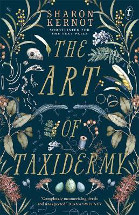The art of taxidermy by Sharon Kernot

Text, Melbourne, 2018. ISBN 9781925603743
(Age: Middle secondary) Highly recommended. Aged eleven, Lotte falls
in love with death. She admires the beauty of a dead gecko, and
keeps it. She and her soulmate Annie find beauty and death linked as
they ramble through the country surrounding their home. Lotte soon
has a collection of bones, skins and feathers in her bedroom. Her
father is tolerant but her aunt, their housekeeper, is appalled by
the smell and the unusual nature of the hobby. As the novel
progresses the reader learns that death has laid a heavy hand on the
family, and that Lotte's interest in death is about preserving both
memories and objects. Lotte's mother died some time ago after the
birth of a stillborn child. Lotte's grandmother is still mourning
the loss of her German-born husband after his internment during the
war in the Loveday camp. There is another grave in the cemetery,
that of Annie, who the reader learns died aged six in a local dam.
Lotte's father has preserved his wife's clothes just as they were
and Lottie's imagined adventures with Annie are an attempt to keep
her memory alive. Lotte's concerned relatives give her a kitten and
a camera as distractions. Lotte's love for the kitten is a
life-affirming emotion; her love for the camera is both
life-affirming and an expression of her need to preserve what she
has. The time comes for her to make choices about a career, but her
aunt is appalled by her interest in taxidermy and suggests that
being a teacher or nurse would be more suitable. However, Lotte's
father takes her to a museum where a taxidermist explains his art.
Lotte is more firmly intrigued and convinced that this will be her
career. She believes that taxidermy is a celebration of life and a
preservation of beauty.
This is a simply written verse novel which covers many issues
without seeming didactic. The attitudes to emigre Germans during
World War II, the difficulties of the Stolen Generation and beliefs
about the role of women in society are minor themes while the main
one is the effect of death and grief. The story evolves quite
dramatically and holds the reader's attention. The poems are easily
read and the descriptions of the natural world are evocative, the
writer having a keen eye for details of shape and colour.
The novel is highly recommended for Middle School readers.
Jenny Hamilton